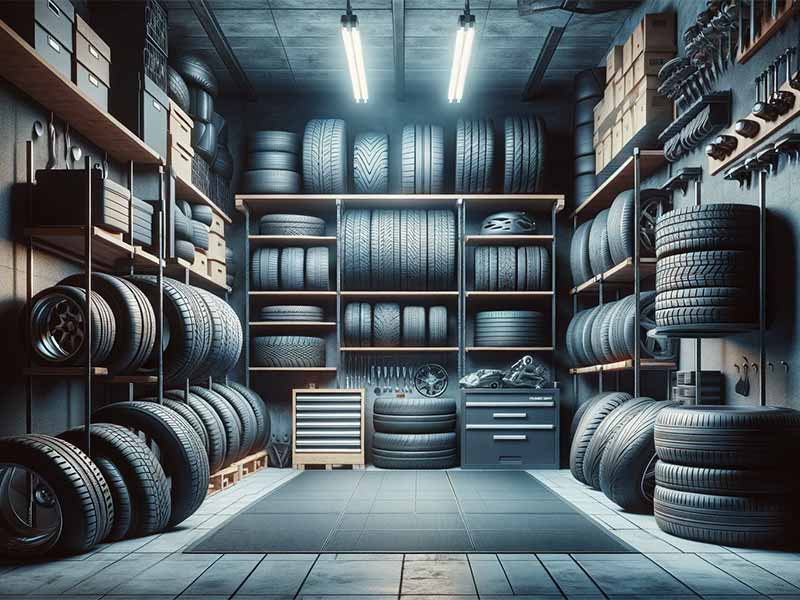Have you ever glanced at your stored tires and wondered if they’re silently deteriorating? Proper long-term storage is crucial to prevent dry rot and ensure your tires are ready to roll when you are. If you’re looking for ways to keep your tires in top shape, avoid common pitfalls, and extend their life, you’re in the right place.
How To Store Tires Long Term
To store tires long term and avoid dry rot, keep them clean, dry, inflated to the correct pressure, and stored in a cool, dark, and ventilated area away from direct sunlight and extreme temperatures.
In this article, we’ll guide you through understanding tire dry rot, preparing your tires for storage, choosing the right environment, positioning and protecting them, and maintaining them while in storage. We’ll also discuss duration and considerations for tire replacement to ensure your safety and tire performance.
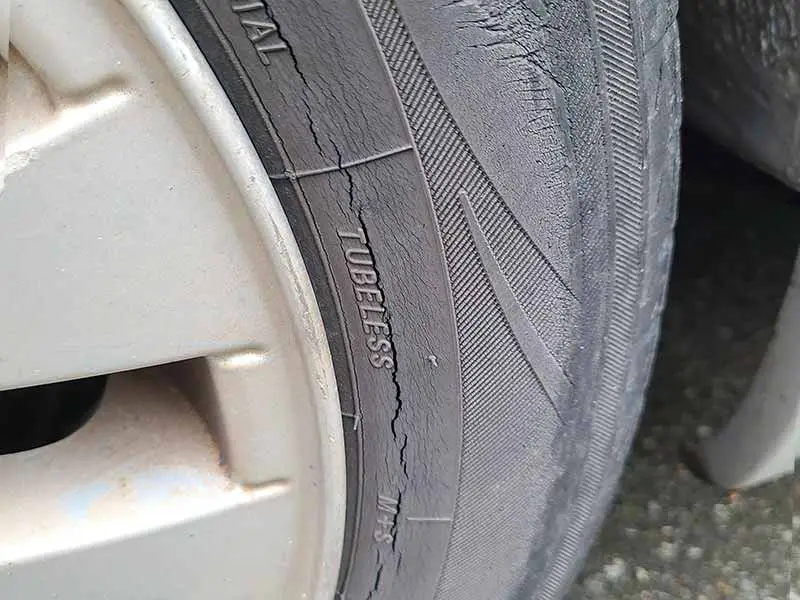
Understanding Tire Dry Rot
Dry rot might sound like something out of a horror movie for your home’s wooden structures, but it’s an equally real and menacing threat to your tires. Here’s what you need to know to keep your tires rolling smoothly for the long haul.
What Exactly is Tire Dry Rot?
Dry rot, scientifically known as tire degradation, is the slow but steady breakdown of the tire compounds. This breakdown occurs when the tire’s essential oils and chemicals begin to evaporate or break down due to:
- Extended exposure to UV rays: Just like how sun can damage your skin, it can degrade your tires too.
- Ozone: Chemical reactions between tire rubber and ozone in the air can accelerate wear.
- Inactivity: Tires are meant to roll. Sitting idle can hasten their demise.
Spotting the Signs
Catching dry rot early can save you a headache down the road. Here are the telltale signs:
- Cracks on the Sidewall: Look for small, web-like cracks. These are the first distress signals your tire might send.
- Brittle Texture: Tires should feel somewhat pliable. If they’re hardening, it’s a bad sign.
- Fading Color: Instead of a deep black, dry rotted tires often fade to a dull gray.
- Loss of Air Pressure: If your tires are constantly needing more air, it could be due to micro-cracks from dry rot.
Why It Matters
Ignoring dry rot doesn’t just mean buying new tires sooner. It’s a safety issue. Dry rotted tires are more prone to:
- Blowouts: Those cracks can lead to catastrophic tire failure, especially at high speeds.
- Decreased Performance: Compromised tires mean less grip and longer stopping distances.
- Leaks and Flat Tires: Small cracks can turn into leaks or leave you stranded with a flat.
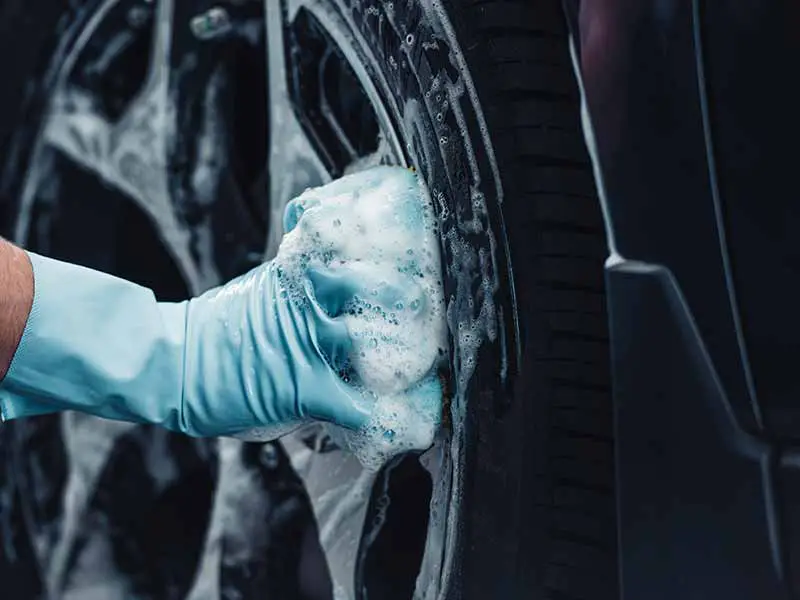
Pre-Storage Preparation
Before you tuck your tires away for a long nap, a little prep work can go a long way. Ensuring your tires are clean, inspected, and in good shape before storage will help prevent dry rot and extend their life. Let’s roll through the steps.
Cleaning Your Tires
A clean tire is a happy tire. Here’s how to properly wash up before storage:
- Remove Debris: Get rid of stones, dirt, and other debris lodged in the treads.
- Soap and Water: Use a mild soap and water solution to wash the tires. Avoid harsh chemicals that can degrade the rubber.
- Dry Thoroughly: Water can be a breeding ground for mold and mildew. Make sure the tires are completely dry before storage.
Inspecting for Damage
A pre-storage check-up can catch problems before they worsen. Here’s what to look for:
- Punctures or Cuts: Small damages can turn big if left unaddressed.
- Worn Treads: Ensure your tires still have life left in them. If the tread is too worn, it might be time to recycle them instead of storing.
- Signs of Early Dry Rot: If you spot small cracks or other symptoms, address them before storage.
Ideal Tire Conditions
Before you store, ensure your tires are in the best possible condition:
- Proper Inflation: Tires should be inflated to the manufacturer’s recommended levels, even during storage.
- No Heavy Loads: Remove any heavy loads from your vehicle or storage area that could put undue stress on the tires.
- Cool, Dry Conditions: Store your tires in a place that’s away from direct sunlight and in a temperature-controlled environment.
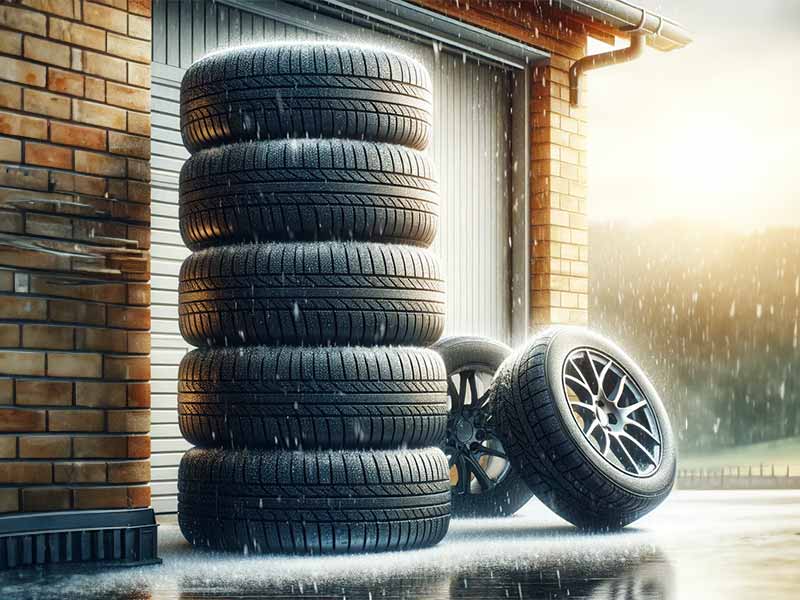
Choosing the Right Environment
The environment where you store your tires can make or break their longevity. Temperature, humidity, and the overall cleanliness of the storage area play pivotal roles in keeping your tires in prime condition. Let’s delve into the ideal conditions for tire storage.
Temperature Considerations
Temperature fluctuations are the nemesis of tire longevity. Here’s how to keep things just right:
- Consistent and Cool: Aim for a storage area that remains consistently cool. Fluctuations can cause the rubber to expand and contract, leading to cracks.
- Avoid Extreme Cold or Heat: Both can accelerate the aging process of the rubber compounds in your tires.
Humidity and Its Effects
Moisture is a tire’s silent enemy. It’s all about balance:
- Dry but Not Desert Dry: You want an environment that’s dry enough to prevent mold and mildew but not so dry that it saps all the moisture from the rubber.
- Ventilation: Good air circulation can help maintain the right humidity level and prevent stagnant air from degrading the tires.
The Importance of a Clean, Dry, and Dark Storage Area
The trifecta of tire storage is clean, dry, and dark. Here’s why:
- Clean: A clean environment prevents oils and chemicals from deteriorating the rubber.
- Dry: As mentioned, dry conditions prevent mold and mildew while keeping the rubber from becoming too brittle.
- Dark: UV and artificial light can both cause rubber to degrade. A dark space prevents this.
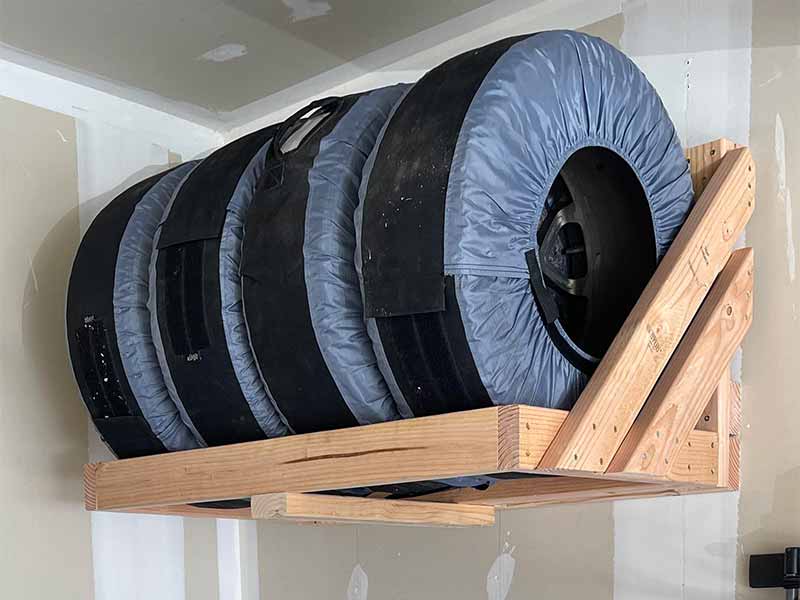
Positioning and Placement of Tires
How you position your tires in storage is more than just an organizational concern; it’s about preserving their shape, structure, and utility for when they hit the road again. Whether you choose to stack, stand, or hang your tires, each method has its own set of guidelines and considerations.
Best Practices for Positioning Tires
Let’s break down the best practices for each storage method:
- Stacked: If you’re stacking tires, do so horizontally. This method is best for tires without rims and should be rotated periodically to prevent flat spots.
- Standing: Tires with rims are best stored upright. It’s a natural position that doesn’t stress any one part of the tire.
- Hung: Hanging is ideal for tires with rims. Ensure they’re hung from hooks that distribute weight evenly to avoid deforming the rim.
Benefits and Drawbacks of Each Storage Method
Each method has its pros and cons:
- Stacked:
- Pros: Saves space and can be easily covered.
- Cons: Risk of flat spots and uneven pressure unless rotated.
- Standing:
- Pros: Minimal stress on tires; easy to inspect and rotate.
- Cons: Takes up more floor space.
- Hung:
- Pros: Excellent for saving space and maintaining tire shape.
- Cons: Requires a proper setup with sturdy hooks and wall space.
Necessary Precautions to Prevent Deformation
No matter the method, keep these precautions in mind to maintain tire integrity:
- Rotate: Periodically rotate stacked or standing tires to distribute weight evenly.
- Avoid Weight: Don’t place heavy objects on or against stored tires.
- Check Pressure: For tires on rims, maintain proper air pressure even during storage.

Tire Covers
Protecting Tires During Storage
Even in the ideal environment, tires need a bit of extra protection to ensure they stay in peak condition. From choosing the right tire covers to understanding the importance of ventilation, let’s cover the essentials of safeguarding your tires.
Covering Tires to Protect from Elements and Ozone
A good cover does more than just hide your tires from sight; it provides a protective barrier against several potentially damaging factors:
- UV Rays: A cover should block out sunlight to prevent UV degradation.
- Ozone: By sealing the tires away, covers can reduce the rubber’s exposure to ozone.
- Dust and Dirt: A clean cover keeps tires clean, avoiding the need for another wash.
Importance of Using Breathable Materials
Not all covers are created equal. Here’s what to look for:
- Breathability: The material should allow moisture to escape to prevent condensation and mold growth.
- Durability: A good cover will resist tears and degradation, ensuring long-term protection.
- Fit: Ensure the cover fits snugly but isn’t so tight that it deforms the tire.
Ventilation Considerations
Proper ventilation in your storage area works hand in hand with good covers:
- Air Circulation: Even with covers, tires benefit from a storage area with good air circulation to prevent stale, moist air from settling.
- Moisture Control: Ventilation helps regulate humidity levels, keeping them within an ideal range to prevent dry rot.
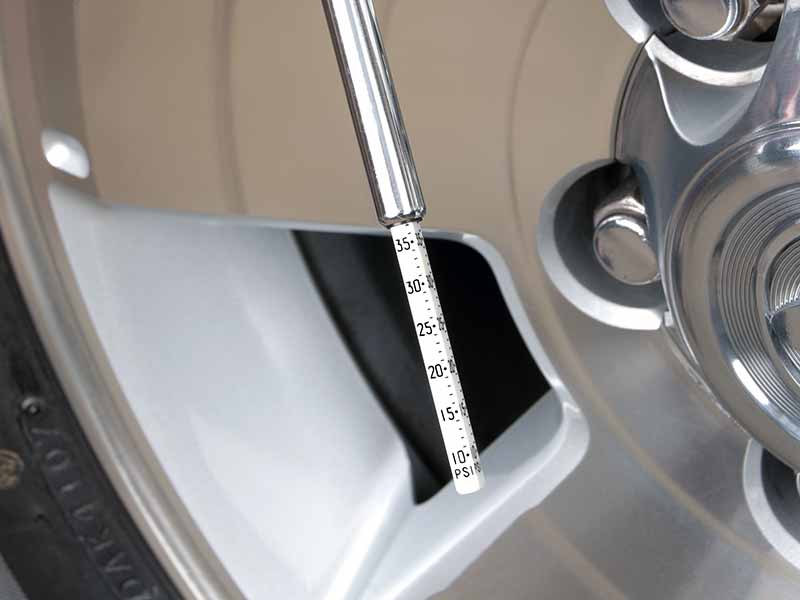
Maintenance While in Storage
Even in their dormant state, tires require a watchful eye and regular care to ensure they remain in optimal condition. Regular checks, repositioning, and air pressure maintenance are key to preventing issues and extending tire life. Let’s navigate through the essential maintenance steps.
Routine Checks and Why They’re Important
Regular inspections can prevent minor issues from becoming major headaches:
- Visual Inspections: Look for any signs of new cracks, bulges, or distortions.
- Air Pressure Checks: Even in storage, tires can slowly lose pressure. Maintain them at the manufacturer’s recommended levels.
- Environment Checks: Ensure that the storage conditions (temperature, humidity, cleanliness) remain optimal.
When and How to Reposition Tires to Prevent Flat Spots
Repositioning your tires periodically is crucial, especially if they’re stacked or standing:
- For Stacked Tires: Every few months, rotate the order of the stack to distribute pressure evenly.
- For Standing Tires: Rotate them slightly to rest on a different part of the tread or sidewall.
- For Hung Tires: While less critical, it’s still good practice to check and adjust the hanging mechanism for even weight distribution.
Air Pressure Maintenance and Its Role in Preserving Tire Shape
Proper air pressure is not just for when tires are in use; it’s vital during storage too:
- Prevents Flat Spots: Correct air pressure helps maintain the tire’s shape, reducing the risk of flat spots.
- Maintains Structural Integrity: Proper inflation supports the tire’s internal structure, keeping it from becoming deformed.
Resources
Below are some links you may find helpful when learning about tires:
- How to store tires to prevent dry rotting and extend their life – Life Storage
- Tire storage tips – Goodyear
Final Thoughts
Storing tires might seem like a simple task, but understanding the nuances can significantly impact their lifespan and your safety.
Cleaning and inspecting your tires to choosing an ideal storage environment and conducting regular maintenance, each step is crucial in avoiding dry rot and other storage-related issues.
Good luck and happy motoring.
